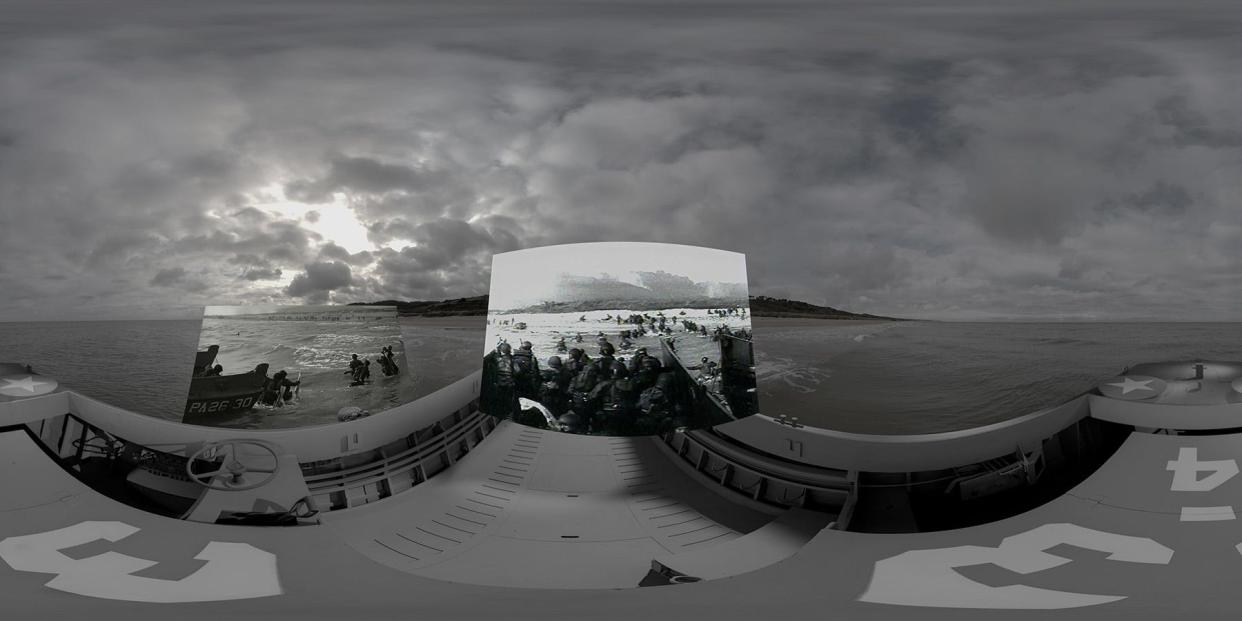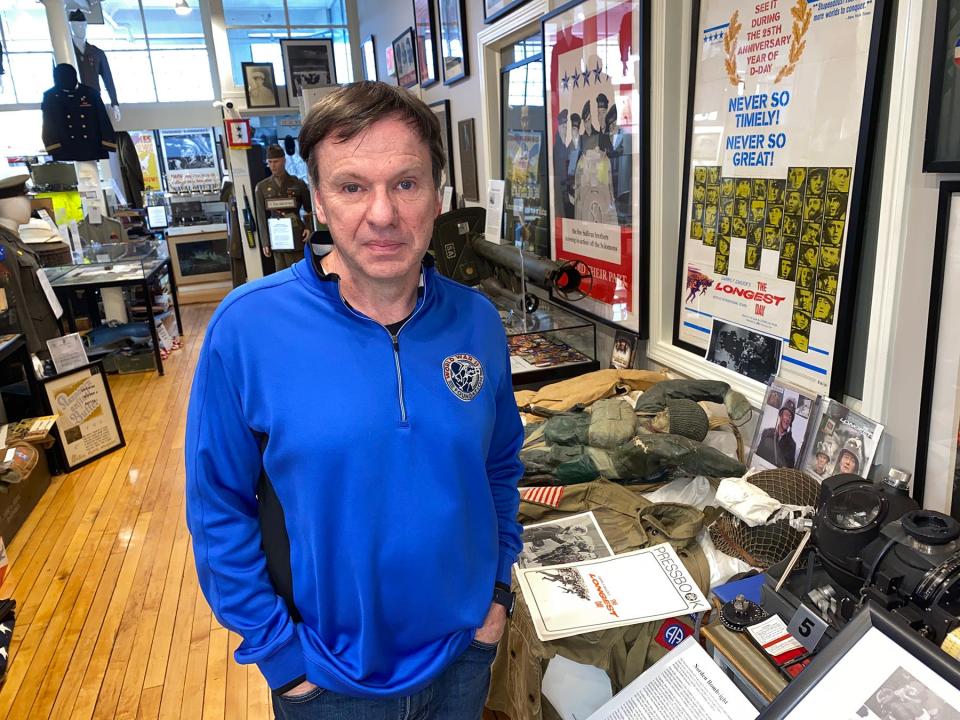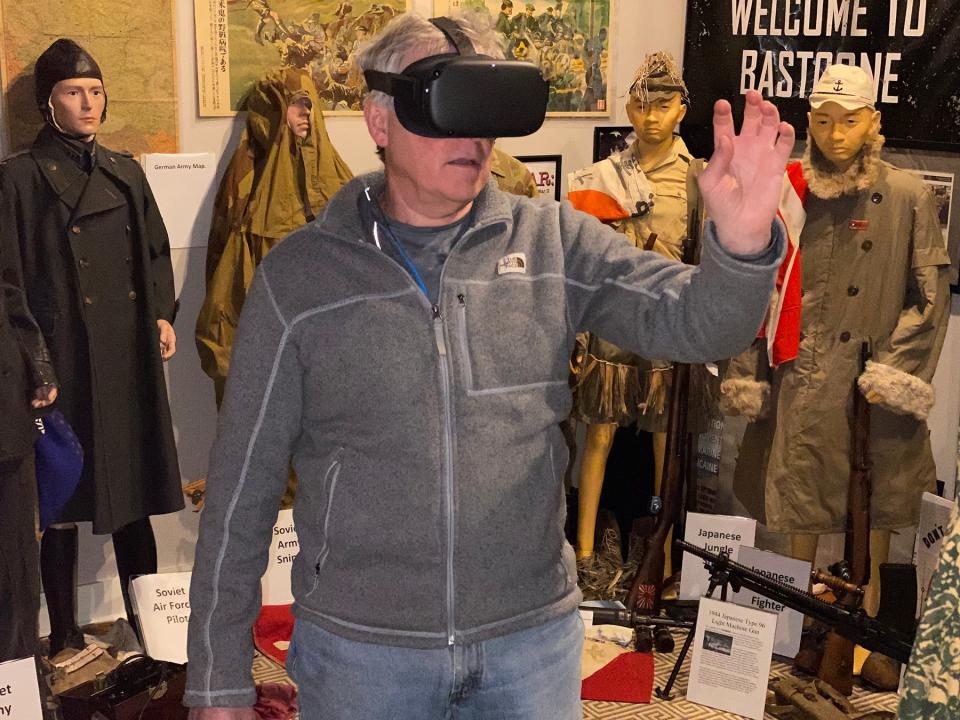D-Day: Under fire at Omaha Beach experienced in virtual reality. Documentarian's passion project

Sometimes, I say yes to a story and then second-guess it.
Like I am now, as I drive to Wakefield.
To see Tim Gray.
Who, don’t get me wrong, I like. And admire. If you ask me, he’s doing God’s work.
He just finished his 29th documentary on World War II, this one narrated by Tom Brokaw.
For his first in 2006, he flew five D-Day vets from Rhode Island back to Normandy.
And now he says he wants to do the same for me.
Except right here.
It’s this amazing technology, he says, that will put me on Omaha Beach, up to my knees in water, with GIs landing around me as Germans send down fire.
His goal, he says, is to teach the video generation about history, and that’s why I’m second-guessing.
A column about some classroom thing?
Patinkin: Rhode Islanders who fought at D-Day as teens recall the day that changed history
No, says Tim, it’s not study material, it’s virtual reality. You know, with the $700 headsets where you experience things like being in a shark cage?
Except Tim created an 18-minute experience, viewed through that headset, putting you in D-Day.
So I park on Main Street in Wakefield and knock, but this isn’t just any door — it leads to an incredible place you can’t believe is in Rhode Island.
Although Tim’s main career is documentaries, he has obsessively collected World War II items, enough to create a museum. Including Anne Frank's own "Grimm's Fairy Tales" book signed by her. A copy of "Mein Kampf" that belonged to Adolf Hitler. A 5-foot piece of the USS Arizona, which went down in Pearl Harbor, and countless weapons, artifacts and real-time headlines.
But this VR thing, he says.

Tim is 55, with the enthusiasm of a kid, and the haircut of one, too. He grew up in Kingston, went to URI, then began a career as a TV sports guy. But after 15 years, he decided that 90 seconds per story was too limiting.
He preferred an hour. And also to focus on what he feels is history’s most important event — World War II.
“We are who we are today because of what they did for us,” Tim says of its veterans.
He takes me to a viewing room, and as I stand, he puts a $700 virtual reality headset over my eyes.
The “experience” is called Omaha Beach VR. It’s archival footage he somehow edited into new video recently shot at Normandy with VR technology.
More: A touching farewell to a RI sailor who survived some of WWII's most brutal combat
I push a start-trigger and right away, all I see is water in 3D and the beach approaching. It’s like being in the front row of IMAX, except it’s 360 degrees, so when you turn, you see silhouettes of some of the more than 5,000 ships that carried 160,000 troops from England to France that day.
Seventy-eight years ago.
Soon, I’m inside a landing craft, reaching out to try to touch the metal walls. I see archival shots of Nazi pillboxes spliced above current video of the beach.

Then I hear the voice of someone I once interviewed — Richard Fazzio of Woonsocket, now, at 96, one of the last surviving Rhode Island D-Day vets.
That day at 6 a.m., at age 19, Fazzio was driving 35 soldiers as coxswain of one of the boats.
“I don’t think there was an atheist in there,” he says in Gray's VR film.
Then he speaks of hearing bullets hitting, and of having no choice but to drop the ramp.
“And the soldiers started pouring out,” he says, “and I seen ‘em dropping. I see ‘em getting shot.” Now Fazzio is crying. “It’s a sight I’ll never forget.”
More: WWII memorial dedicated in Woonsocket: 'Our duty is to make sure that we never forget'
That’s when a bullet hit him under his arm and went out his back.
Then you feel you’re on the beach, and you hear the remembrance of infantryman Harold Baumgarten of the Bronx.
“I looked up,” he says, “and an 88 went off in front of me. Ripped my cheek off, ripped my upper jaw off, a hole in the roof of the mouth, teeth and gums on my tongue.”
But there was worse around him.
“One of my best buddies had his face shot off. All these guys you knew as your friends, you trained with them, they’re laying dead.”
And yet he had to keep going.
You feel you’re going, too, as you have no visual of the room, or even your own body - just the 360 panorama inside the headset.
Patinkin: Love and war: RI's last WWII couple reflect on their service
Steven Spielberg, Tim told me, later consulted Baumgarten for the D-Day scene in “Saving Private Ryan.”
That’s some scene.
I doubted any other could make you experience that day as intensely.
But Tim Gray’s virtual reality put you right there — surrounded by shots of real soldiers, not actors.
I’m glad I said yes to this story.
mpatinki@providencejournal.com
This article originally appeared on The Providence Journal: Under fire on Omaha Beach: Experienced D-Day in virtual reality

